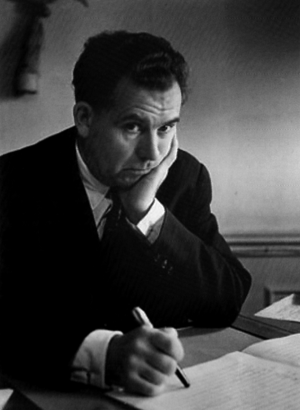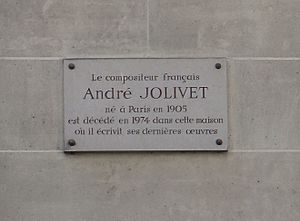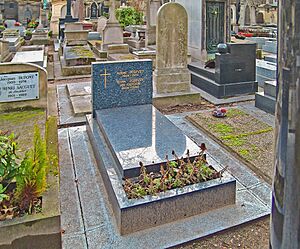André Jolivet facts for kids
André Jolivet (born August 8, 1905 – died December 20, 1974) was a French composer. He was known for loving French culture and music. Jolivet was interested in how sounds work (acoustics) and in music without a clear key (atonality). He also used ideas from both old and new music, especially instruments from ancient times. He wrote many different kinds of music for various groups of instruments.
Contents
Life of André Jolivet
André Jolivet was born in Paris, France, on August 8, 1905. His father, Victor-Ernest Jolivet, was an artist, and his mother, Madeleine Perault, was a pianist. André became interested in art early on. When he was 14, he started painting and learning to play the cello.
His parents wanted him to become a teacher. So, he went to a teachers' college and taught at a primary school in Paris. He also spent three years serving in the military. One of his own teachers believed he had a bright future in music. This teacher strongly encouraged him to compose music and introduced him to Paul Le Flem. Le Flem was Jolivet's first composition teacher. He taught Jolivet the basics of classical music, like harmony and counterpoint.
After hearing music by Arnold Schoenberg, Jolivet became interested in atonal music. This is music that doesn't follow traditional keys. Le Flem then suggested he study with Edgard Varèse. Jolivet became Varèse's only student in Europe. Varèse taught him about musical acoustics, atonal music, and how to arrange music for orchestras.
In 1936, Jolivet helped start a group called La jeune France. Other composers in this group were Olivier Messiaen, Jean-Yves Daniel-Lesur, and Yves Baudrier. They wanted to create music that felt more human and less abstract. This group grew out of an earlier music society called La Spirale, which Jolivet, Messiaen, and Daniel-Lesur formed a year before.
His Family Life
Jolivet was married twice. First, he married violinist Martine Barbillion in 1929. They had a daughter named Francoise-Martine. In 1933, he married Hilda Ghuighui. They had three children: Pierre-Alain, Christine, and Merri.
His Passing
André Jolivet passed away in Paris in 1974 when he was 69 years old. He left an opera called Le Soldat inconnu unfinished. He was buried in Montmartre Cemetery, next to another composer, Henri Sauguet.
André Jolivet's Career
Jolivet's ideas about music changed a lot during his career. When he was young, he wanted to write music for plays and ballets. This led to some of his first pieces. Later, he was inspired by composers like Claude Debussy, Paul Dukas, and Maurice Ravel. He wrote several piano pieces while training to be a teacher, before studying with Le Flem.
His early mature works showed strong influences from Schoenberg and Varèse. His style used a lot of atonality and modern ideas. For example, Mana (1933) was a piano work with six parts. Each part was named after an object Varèse left with him. Jolivet's main goal as a composer was to "give back to music its original, ancient meaning." He believed music used to be a magical way to express religious beliefs. Mana showed this idea even in his early works. He continued to explore music's original meanings and its power for emotion, rituals, and celebrations.
In 1945, Jolivet wrote that "true French music owes nothing to Stravinsky." Both composers used ancient music themes, but Jolivet and his group La jeune France preferred a more spiritual style. They did not like the mechanical style of neoclassicism. During World War II, Jolivet moved away from atonality. He started writing music that was more melodic and had clear keys. After writing in this simpler style for a few years, he found a balance between it and his earlier experimental work. His First Piano Sonata (1945) shows parts of both styles.
Jolivet finally achieved his dream of writing for the theater. In 1945, he became the music director for the Comédie Française, a famous French theater. He held this job until 1959. There, he wrote music for plays by famous writers like Molière, Racine, Sophocles, Shakespeare, and Claudel. He scored 14 works in total. He also kept writing music for concerts. His frequent travels around the world often inspired him. He used texts and music from Egypt, the Middle East, Africa, and Asia, blending them into his unique French style.
In the 1950s and 1960s, Jolivet wrote several concertos. These are pieces for a solo instrument and an orchestra. He wrote them for many instruments, including trumpet, piano, flute, harp, bassoon, percussion, cello, and violin. These works are highly respected, but they need very skilled musicians to play them. Jolivet was also one of the few composers to write for the ondes Martenot. This was an early electronic instrument. He finished a concerto for it in 1947, 19 years after the instrument was invented. In 1959, Jolivet started the Centre Français d'Humanisme Musical in Aix-en-Provence. In 1961, he began teaching composition at the Paris Conservatoire, a famous music school.
Selected Works
Here are some of André Jolivet's important musical works:
Chamber and Solo Music
- 12 Inventions, for wind instruments and strings
- Andante and adagio, for strings
- Chant de Linos, for flute, violin, viola, cello, and harp (1944)
- Chant d'oppression, for viola and piano (1935)
- Cinq danses rituelles (1939)
- Cinq églogues, for solo viola (1967)
- Cinq incantations, for flute (1936)
- Cosmogonie, for piano (1938)
- Cérémonial, for six percussion instruments
- Deux études de concert, for guitar (1965)
- Fantaisie-Impromptu, for saxophone and piano (1953)
- Hymne à l'univers, for organ
- Mana, six pieces for piano (1935)
- Mandala, for organ
- Pastorales de Noël, for flute, bassoon, and harp (1943)
- String Quartet (1934)
- Rhapsodie à sept, for seven wind and string instruments (1957)
- Sérénade, for two guitars (1956)
- Sérénade, for wind quintet with main oboe (1945)
- Sonata, for flute
- Sonatine, for flute and piano (1961)
- Sonatine, for flute and cello
- Sonatine, for flute and clarinet
- Sonatine, for oboe and bassoon (1963)
- Suite delphique, for 12 instruments (1943)
- Suite en concert, for flute and four percussion instruments (1965)
- Suite en concert, for cello (1965)
- Tombeau de Robert de Visée, for guitar (1972)
Keyboard Music
- Cinq danses rituelles, for piano (1939)
- Cosmogonie, for piano (1938)
- Hymne à l'univers, for organ (1961)
- Mana, six pieces for piano (1935)
- Mandala, for organ (1969)
- Six Etudes, for piano (1931)
- Sonata, for piano (1945)
- Sonata, for piano (1957)
- Trois Temps No. 1, for piano (1931)
- Trois Temps No. 2, for piano (1931)
Concertos (Solo Instrument with Orchestra)
- Concerto for ondes Martenot and orchestra (1947)
- Concertino for trumpet, piano, and string orchestra (1948)
- Concerto for flute and strings (1949)
- Concerto for piano (1951)
- Concerto for harp and chamber orchestra (1952)
- Concerto for bassoon, strings, harp, and piano (1954)
- Concerto for trumpet (1954)
- Concerto for percussion (1958)
- Concerto for cello number 1 (1962)
- Concerto for flute and percussion (1965)
- Concerto for cello number 2 (1966)
- Concerto for violin (1972)
Orchestral Music
- 3 Symphonies (1954, 1959, 1964)
- Cinq danses rituelles (orchestral version, 1941)
- Cosmogonie (orchestral version, 1938)
- Danse incantatoire (1936)
- Suite delphique, for strings, harp, ondes Martenot, and percussion (1943)
- Symphony for strings (1961)
Vocal Music
Songs
- Les trois complaintes du soldat, for voice and orchestra (1940)
- Poèmes pour l'enfant, for voice and eleven instruments (1937)
- Songe à nouveau rêvé, concerto for soprano and orchestra
- Suite liturgique for voice, oboe, cello, and harp (1942)
- Épithalame, for 12-part choir (1953)
Sacred Music
- La vérité de Jeanne, oratorio (1956)
- Mass Uxor tua (1962)
- Messe pour le jour de la paix (1940)
Ballets
- Ariadne (1964)
- Ballet des étoiles (1941)
- Guignol et Pandore (1943)
- L'inconnue
- Les quatre vérités
- Marines
Operas
- Antigone
- Bogomil (unfinished)
- Dolorès ou Le miracle de la femme laide (1942)
See also
 In Spanish: André Jolivet para niños
In Spanish: André Jolivet para niños




